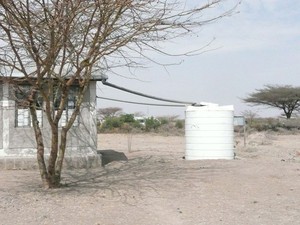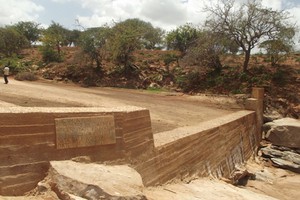Rainwater
In regions where rainfall is abundant and frequent, rainwater can be a good source of water supply for individual families and small communities. The storage of rainwater is particularly important in areas with a long dry season, or where groundwater or surface water is difficult to obtain or polluted. The term rainwater harvesting is sometimes used. It simply means collecting, or harvesting, rainwater as it runs off from hard surfaces and storing it in a tank or cistern. Rainwater has several advantages. It is free, relatively clean and usually reliable, even if it rains only once or twice a year, and a rainwater harvesting system can be easily constructed and maintained at low cost. Although mainly found in rural areas, rainwater harvesting can also be useful in an urban situation.
Rainwater can be collected in several ways:
Roof catchments
Rainwater can be collected from house roofs made of tiles, slate, (corrugated) galvanised metal or equivalent. Pipes feed water from the roof and gutters into a collection tank where it can be stored until needed (Figure 3.13).

Figure 3.13 Rainwater is collected from the roof of this rural health post and stored in a covered, watertight cistern.
If rainwater is used for water supply, it is important to ensure that it is not contaminated by improper methods of storage, or by bird droppings and leaves from the roof that it is collected from. Rainwater may be also be contaminated by pollutants in the air, dust, dirt, paint and other material on the roof or in roofing materials. All of these contaminants can be washed into the storage tank or cistern.
To protect the water, various precautions are needed. The tank must be completely covered and well-maintained. The roof and gutters should be cleaned regularly, especially before the start of the wet season. It may be necessary to divert the first rainwater away from the tank so that dust and dirt are washed away. Leaves and other larger debris can be prevented from entering the tank by placing a mesh screen between the guttering and the pipe that leads to the tank; the mesh screen will need to be cleaned regularly.
Ground catchments
These are systems that collect and store rain falling on an area of ground (Figure 3.14). The amount of rainwater that can be collected depends on whether the area is flat or sloping, and on the permeability of the top layer of the ground. These systems require space so are only appropriate in rural areas, where they can serve small villages and households for livestock and vegetable growing.

Figure 3.14 Rainwater storage ponds in Amhara Region.
Sand dams
In arid areas where there is a dry, sandy riverbed and the rain falls once or twice a year, a collection system known as a sand dam can be used to store water. A sand dam (Figure 3.15) is a concrete wall (1 to 5 m high) built across a seasonal sandy riverbed. During the rainy season, a seasonal river forms and carries sand and silt downstream. The heavy sand accumulates behind the dam, while the lighter silt washes downstream over the dam wall. Within one to four rainy seasons the dam completely fills with sand. However, up to 40% of the volume held behind the dam is actually water stored between the sand particles. The water can be abstracted from the sand dam via a slotted pipe buried in the sand that either passes through the dam wall or is connected to a simple hand pump situated on the river bank.

Figure 3.15 A sand dam in Kenya.